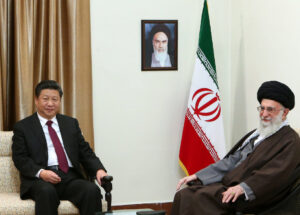By Dr. Mordechai Chaziza
 EXECUTIVE SUMMARY: The successful implementation of China’s BRI strategy will largely depend on its ability to overcome the Middle East’s weighty political, economic, religious, cultural, and security problems.
EXECUTIVE SUMMARY: The successful implementation of China’s BRI strategy will largely depend on its ability to overcome the Middle East’s weighty political, economic, religious, cultural, and security problems.
The Middle East is situated at the heart of Beijing’s Belt and Road Initiative (BRI). This initiative, which is also referred to as the New Silk Road, is one of the most ambitious infrastructure projects in modern history and has the potential to completely reconfigure global trade routes.
The BRI aims to deepen and expand links between Asia, the Middle East, Europe, and Africa by recreating the ancient Silk Road trade routes through both land and sea. The Middle East occupies a strategic position at the intersection of the Silk Road Economic Belt (SREB) and the 21st Century Maritime Silk Road Initiative (MSRI). It sits at the juncture of Asia, Africa, and Europe. It has vital maritime chokepoints (Strait of Hormuz, Strait of Bab al-Mandab, and the Suez Canal) that are critical for the global energy transport system. The Middle East is thus a key to the success of the new Silk Road strategy—especially to the MSRI, as many of the relevant straits, sea routes, hubs, and offshoots run through the region.
Although the Middle East is not considered the primary geopolitical sphere of influence for China (a distinction reserved for the East and South China Seas), the region is of greater importance to Beijing than ever before. China now views the Middle East as an extension of its periphery. It seeks to develop relationships with Middle Eastern states to secure energy imports, secure exports via routes that pass through the region, and, over the longer term, increase its regional influence and displace the US in the Middle East.
But the BRI’s prospects for success in the Middle East must be assessed in the context of the region’s particular religious and cultural features, issues, and challenges. These include the Islamic religion and cultural value system, social class gaps, and ethnic and religious problems, and extend to the Chinese lack of knowledge about local regulations as well as labor and commercial disputes. Most of the world’s hot issues and conflicts are concentrated in the Middle East.
Islam dominates the region. As a religion and sociocultural value system, it has profound influence on local societies and economies. With the expansion of the New Silk Road, there will be inevitable interactions between the Islamic and Chinese cultures. Cultural, cognitive, religious, and language differences are bound to affect person-to-person bonds and diplomatic relations. Beijing will also need to consider that Islam might use the New Silk Road to penetrate further eastward and reinforce the religious consciousness of the local Muslim population in China’s northwest.
The primary key to the success of the BRI is stability in the Middle East, a goal that appears to be far beyond China’s geopolitical capacity. Most states in the region are developing countries that are affected by complex factors like social class gaps and ethnic and religious strife. The more Beijing engages economically in the region, the more exposed it is to the consequences of regional and local instability. To guarantee the success of the BRI, China should contribute to the settlement of Middle Eastern conflicts.
Beijing has indeed become more concerned about the stability of Middle Eastern regimes. Its growing regional interests combined with its BRI ambitions underscore that Middle East stability, particularly in the Persian Gulf, is now a matter of strategic concern for China. Beijing has traditionally avoided deep entanglements in Middle Eastern affairs by adopting a neutral position. Now that it wants to promote regional economic prosperity under the framework of the BRI, it is advocating political settlements of the region’s conflicts. This is meant to foster stability and cement China’s influence as a newly emerged great power at minimum cost.
However, the more China is engaged in Middle Eastern disputes, the higher the risk that it will be sucked into them. The BRI will not be implemented smoothly without a proper settlement of the conflicts in the region. If that is the case, Beijing will have to adopt a more proactive attitude toward regional problems.
Chinese companies participating in the construction of BRI infrastructure in the Middle East will need more and more skilled local workers. However, Chinese ignorance of local regulations and deficiencies at the operational level have led to a rise in labor and commercial disputes.
The region’s instability is forcing China to confront severe challenges as it attempts to implement the BRI. Its ability to achieve its objectives in the region depends largely on the security and economic situation in the region, but also on the knowledge China has accumulated over its historical experience in the Middle East.
The New Silk Road strategy is a complicated foreign policy challenge. It is a massive, slow-moving project that will unfold over decades. It is functionally and geographically vast, and will involve a great many Chinese companies and local agencies. The project requires China to grapple with political, economic, religious, cultural, and security issues. The critical question is whether it will know how to overcome the challenges posed by religious and cultural differences in the Middle East.
No comments:
Post a Comment